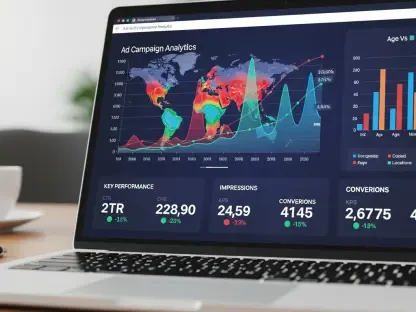The Holiday Marketing Landscape in 2025
The holiday season remains a cornerstone of revenue generation for brands, with digital marketing playing a pivotal role in capturing consumer attention during this high-stakes period. As shoppers flood online platforms, the intensity of competition among retailers and tech giants escalates, driving innovation and strategic shifts. Digital channels such as social media, email campaigns, and e-commerce marketplaces have become indispensable, with major industry players leveraging these tools to maximize reach and engagement. Consumer expectations are evolving rapidly, demanding seamless experiences, personalized offers, and transparent communication from brands navigating this bustling marketplace.
Technology continues to redefine how holiday campaigns are crafted and executed, with AI-driven advertising and sophisticated data analytics leading the charge. These advancements enable marketers to predict trends, optimize ad spend, and deliver tailored content that resonates with diverse audiences. Beyond technology, economic pressures like inflation and social dynamics such as shifting trust in digital platforms are influencing how brands approach their strategies. The intersection of these factors creates a complex environment where adaptability and insight are essential for success in the holiday rush.
Core Trends Driving Holiday Digital Marketing
Economic Disparities and Shifting Consumer Behaviors
A stark divide in consumer spending power, often described as a K-shaped economy, is reshaping holiday marketing approaches. Top earners contribute a significant portion of total spending, while many households grapple with constrained budgets due to income inequality. This disparity forces brands to rethink their messaging, balancing premium offerings for affluent customers with value-driven campaigns for those prioritizing affordability during the festive season.
Inflation and concerns over tariffs further complicate the landscape, heightening price sensitivity among shoppers. With many consumers cautious about discretionary purchases, marketers face the challenge of positioning products as essential or cost-effective. Data suggests an average holiday spend of $890.49 per person, reflecting a real decline of 4.3% when adjusted for inflation, underscoring the need for strategic pricing and promotions.
This economic backdrop opens opportunities for precise audience segmentation. Brands can tailor communications to highlight deals and savings for budget-conscious shoppers while maintaining aspirational narratives for higher-income groups. Crafting messages that emphasize value without compromising on quality becomes a critical tactic in addressing these varied financial realities.
Trust Dynamics and Channel Evolution
Trust in social media and influencer marketing is waning, driven by concerns over AI-generated content and undisclosed paid promotions. Consumers are increasingly skeptical of the authenticity of online endorsements, pushing them toward more reliable sources of information. This shift marks a significant pivot in how digital marketers allocate budgets and select channels for holiday campaigns.
Online reviews, word-of-mouth recommendations, and even a resurgence of traditional media are gaining traction as credible alternatives. Surveys indicate that consumers now place greater faith in peer feedback and established outlets over viral posts or celebrity endorsements. This trend suggests that brands must prioritize platforms and tactics that foster genuine connections and verifiable social proof during the holiday peak.
Looking ahead, these trust dynamics are likely to steer investments toward channels that emphasize transparency and authenticity. Marketers may need to reallocate resources to build stronger relationships through customer testimonials and trusted editorial content. Adapting to this evolving preference for credibility could redefine engagement strategies in the coming holiday seasons.
Challenges Facing Holiday Digital Marketers
Navigating economic challenges poses a significant hurdle for holiday marketers striving to balance profitability with consumer demand for discounts. With inflation impacting purchasing power, brands often face pressure to offer competitive pricing while protecting their margins. This delicate equilibrium requires innovative approaches to discounting and bundling that maintain perceived value without eroding profits.
The diversity in consumer financial capacity adds another layer of complexity, as marketers must address a fragmented audience with distinct needs and expectations. Crafting campaigns that resonate across income brackets demands localized messaging and a deep understanding of regional economic conditions. Failing to account for these differences risks alienating key segments of the market at a critical time.
Rebuilding trust in digital channels amidst widespread misinformation and skepticism remains an uphill battle. Consumers are wary of manipulative tactics and inauthentic content, challenging brands to demonstrate integrity in their interactions. Leveraging trusted platforms, ensuring transparency in promotions, and focusing on genuine storytelling are potential strategies to overcome these obstacles and foster lasting customer loyalty.
Regulatory and Ethical Considerations in Digital Marketing
The regulatory environment surrounding digital marketing continues to tighten, with data privacy laws like GDPR and CCPA imposing strict guidelines on how consumer information is handled. During the holiday season, when data collection for personalized ads peaks, compliance becomes even more critical. Brands must ensure that their practices align with these regulations to avoid penalties and maintain customer confidence.
Advertising standards and platform policies also demand attention, particularly in terms of transparency around promotions and sponsored content. Ethical concerns, such as the use of AI-generated material and the authenticity of influencer partnerships, are under scrutiny as consumers grow more discerning. Non-compliance or perceived deception can quickly damage a brand’s reputation during the high-visibility holiday period.
These regulatory shifts are poised to impact how personalized advertising is deployed, potentially limiting the scope of data-driven targeting. Marketers must adapt by prioritizing consent-based data practices and exploring alternative methods for customization. Balancing innovation with ethical responsibility will be key to sustaining trust and effectiveness in holiday campaigns.
Future Outlook for Holiday Digital Marketing
Emerging technologies, including advanced AI tools for hyper-personalization and predictive analytics, are set to transform holiday marketing strategies. These innovations enable brands to anticipate consumer behavior with greater accuracy, crafting offers that align with individual preferences. As adoption grows, such tools could become indispensable for optimizing campaign performance in competitive seasons.
Potential disruptors, such as the rise of new social platforms or unexpected economic shifts, may further influence marketing directions in the years ahead. Staying agile and monitoring these developments will be crucial for brands aiming to maintain relevance. Additionally, evolving consumer preferences for authenticity, value, and local production—evidenced by growing interest in “Made in the USA” messaging—signal a shift toward more meaningful purchasing decisions.
Global economic conditions, innovations in ad formats, and ongoing regulatory trends will continue to shape the trajectory of holiday marketing. Brands that invest in understanding these macro-level influences can position themselves to capitalize on emerging opportunities. The ability to adapt to a dynamic environment will define success in future festive campaigns.
Conclusion and Strategic Recommendations
Reflecting on the insights gathered, it becomes evident that economic disparities, inflation alongside tariff concerns, declining trust in social media, and the pivot to credible channels have profoundly influenced holiday digital marketing strategies. These trends collectively highlight a season marked by cautious consumer behavior and a demand for authenticity in brand interactions. Marketers who recognize and adapt to these shifts gain a competitive edge by aligning their efforts with evolving expectations.
Moving forward, actionable steps emerge as vital for sustained success. Brands are encouraged to deepen audience segmentation, ensuring campaigns address diverse financial realities with tailored value propositions. Investing in trusted channels like online reviews and traditional media proves effective in rebuilding consumer confidence. Moreover, emphasizing local production in messaging resonates with shoppers seeking meaningful purchases amidst economic uncertainty.
A forward-thinking approach also suggests exploring untapped potential in technology and data ethics to enhance personalization without compromising trust. By viewing these challenges as catalysts for innovation, marketers find opportunities to forge stronger connections with consumers. This mindset of agility and customer-centric focus lays a robust foundation for navigating future holiday seasons with confidence and impact.









